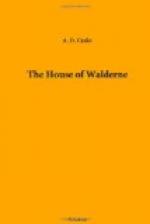The reader must remember that nearly all the friars were laymen; lay preachers, as we would say; preaching was not then considered a special clerical function.
Martin could not speak for joy, but soon tears were seen to start down his cheeks.
“I was thinking of my poor mother. Oh, that she had lived to see this day,” he exclaimed, as he saw the prior observe his emotion.
The reader will remember that news of her death had reached Martin soon after his arrival at Kenilworth, without which he could not have remained all these years away from the Andredsweald. Her death had partially (only partially) snapped the link which bound him to his kindred, the love of whom now began to revive in the breast of the convalescent.
Chapter 14: May Day In Lewes.
It was the May Day of 1259, one of the brightest days of the calendar. The season was well forward, the elms and bushes had arrayed themselves in their brightest robe of green; the hedges were white and fragrant with may; the anemone, the primrose, the cowslip, and blue bell carpeted the sward of the Andredsweald; the oaks and poplars were already putting on their summer garb. The butterflies settled upon flower after flower; the bees were rejoicing in their labour; their work glowed, and the sweet honey was fragrant with thyme.
Oh how lovely were the works of God upon that bright May Day, as from village church and forest sanctuary the population of Sussex poured out from the portals, after the mass of Saints Philip and James; the children bearing garlands and dressed in a hundred fantastic hues, the May-poles set up on every green, the Queen of May chosen by lot from amongst the village maidens.
Never were sweeter nooks, wherein to spend Maytide, than around the villages and hamlets of the Andredsweald, whither the action of our tale betakes itself again—around Chiddinglye, Hellinglye, Alfristun, Selmestun, Heathfeld, Mayfeld, and the like—not, as now, accessible by rail and surrounded by arable lands; but settlements in the forest, with the mighty oaks and beeches which had perchance seen the coming of Ella and Cissa, long ere the Norman set foot in Angleland; and with solemn glades where the wind made music in the tree tops, and the graceful deer bounded athwart the avenue, to seek refuge in tangled brake and inaccessible morass.
Chief amongst these Sussex towns and villages was the old borough of Lewes, distinguished alike by castle and priory. The modern visitor may still ascend to the summit of the highest tower of that castle, but how different (yet how much the same) was the scene which a young knight viewed thence on this May Day of 1259. He had come up there to take his last look at the fair land of England ere he left it for years, it might be never to return.
“It is a fair land; God keep it till I return.”
The great lines of Downs stretched away—northwest to Ditchling Beacon; southwest to Brighthelmston, a hamlet then little known; on the east rose Mount Caburn, graceful in outline (recalling Mount Tabor to the fond remembrance of the crusaders); southeast the long line stretched away by Firle Beacon to Beachy Head.




